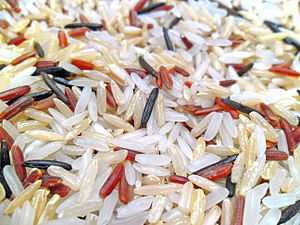Black rice
Black rice (also known as purple rice) is a range of rice types of the species Oryza sativa L. , some of which are glutinous rice. Varieties include but are not limited to Indonesian black rice and Thai jasmine black rice. Black rice is high in nutritional value and is a source of iron, vitamin E, and antioxidants (more than in blueberries).[1] The bran hull (outermost layer) of black rice contains one of the highest levels of anthocyanin antioxidants found in food.[2] The grain has a similar amount of fiber to brown rice and like brown rice, has a mild, nutty taste.[3][4] In China, black rice is claimed to be good for the kidney, stomach and liver. Black rice has a deep black color and usually turns deep purple when cooked. Its dark purple color is primarily due to its anthocyanin content, which is higher by weight than that of other colored grains.[5][6] It is suitable for making porridge, dessert, traditional Chinese black rice cake or bread. Noodles have also been produced from black rice.
Thai black jasmine rice, while not as prevalent as the white and brown varieties, adds more vibrant color to meals, as well as providing additional health benefits.[7]
Economic importance
The black and white aromatic rices (Chakhao amubi, Chakhao poireiton and Chakhao angouba) of Manipur in India, have their importance as a glutinous or sticky rice and are used for the community feast as well as ceremonial purposes as delicacy. Chak means rice and ahaoba means delicious, therefore, Chakhao means delicious rice. It is sold in the local markets at about Rs. 325 per kg of rice . The black aromatic rice of Manipur is served in standard hotels as a top rated variety of rice . Rice flake prepared from black rice is becoming popular . As the black glutinous aromatic rices of Manipur are poor yielders (about 2,500 kg/ha as paddy), these rices cover only less than 10% of the rain-fed wetland area under local cultivars, although there is a premium in the price of these rices .
History
It is believed that Chakhao of Manipur came with the people of Manipur, particularly Meiteis when they first settled on this land.[8] The words Amubi and Angouba stand for black and white, respectively, in Manipuri. Hence, Chakhao amubi and Chakhao angouba were named after the black and white color glutinous aromatic rice endosperm of these cultivars.
Improvement
No systematic work on the improvement of black glutinous aromatic rice of Manipur has so far been taken up. However, germplasm collection, characterization and evaluation of these aromatic rice cultivars of have been made. The black glutinous aromatic rice of Manipur have been characterized for 34 morphological characters. These aromatic rice cultivars have been evaluated for eleven morpho-agronomic characters along with reaction to major diseases and pests of local importance.
As the domestic demand for the black glutinous aromatic rice of Manipur increases, efforts are to being made to develop high yield varieties without losing the grain's quality, cooking quality and aroma. The black glutinous aromatic rice of Manipur is in demand in the domestic market, as well as having possibilities for export.
References
- ↑ Whole Grain Council "BLACK RICE RIVALS BLUEBERRIES AS ANTIOXIDANT SOURCE", Zhimin Xu at the Louisiana State University Agricultural Center Study, August 26, 2010, (note: presentation at the National Meeting of the American Chemical Society, Boston MA)
- ↑ Yao, S. L.; Xu, Y; Zhang, Y. Y.; Lu, Y. H. (2013). "Black rice and anthocyanins induce inhibition of cholesterol absorption in vitro". Food & Function 4 (11): 1602–8. doi:10.1039/c3fo60196j. PMID 24056583.
- ↑ "Food Grains of India". 232-234 1892. p. 234.
- ↑ Willett, Brian (14 September 2011). "Nutrition Differences in Black Rice Vs. Brown Rice". LIVESTRONG (Lance Armstrong Foundation). Retrieved 24 April 2012.
- ↑ Takashi Ichiyanagi, Bing Xu, Yoichi Yoshii, Masaharu Nakajima, Tetsuya Konishi, "Antioxidant Activity of Anthocyanin Extract from Purple Black Rice." Journal of Medicinal Food. December 1, 2001, 4(4): 211-218.
- ↑ Abdel-aal El-Sayed M.; Young J. Christopher; Rabalski Iwona. "Anthocyanin composition in black, blue, pink, purple, and red cereal grains." Journal of agricultural and food chemistry. 2006, vol. 54: 13, p. 4696-4704.
- ↑ Lynch, William (14 June 2011). "Jasmine Black Rice Nutrition". LIVESTRONG (Lance Armstrong Foundation). Retrieved 24 April 2012.
- ↑ Singh, R.K.; Baghel, S.S. (2003), "Aromatic Rices of Manipur" (PDF), A Treatise on the Scented Rices of India (1st. ed.), New Delhi: Kalyani Publishers, pp. 347–354, ISBN 8127210315
